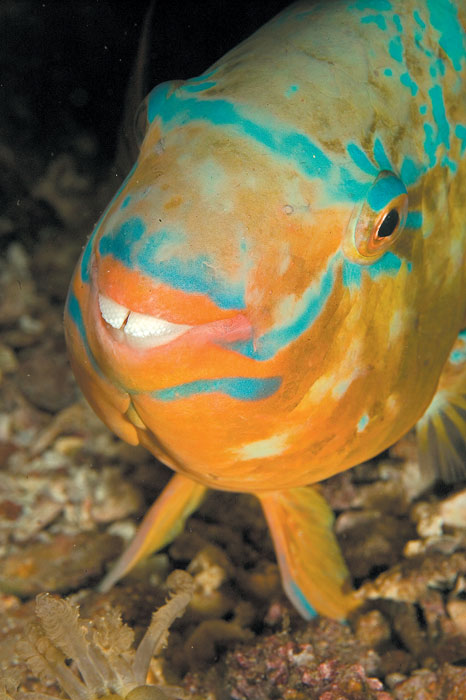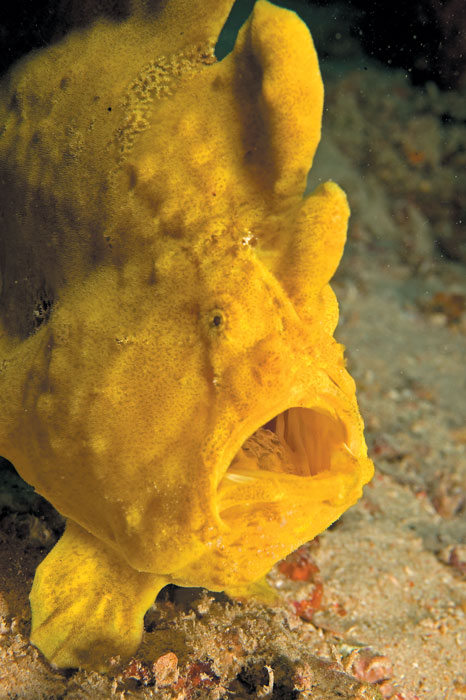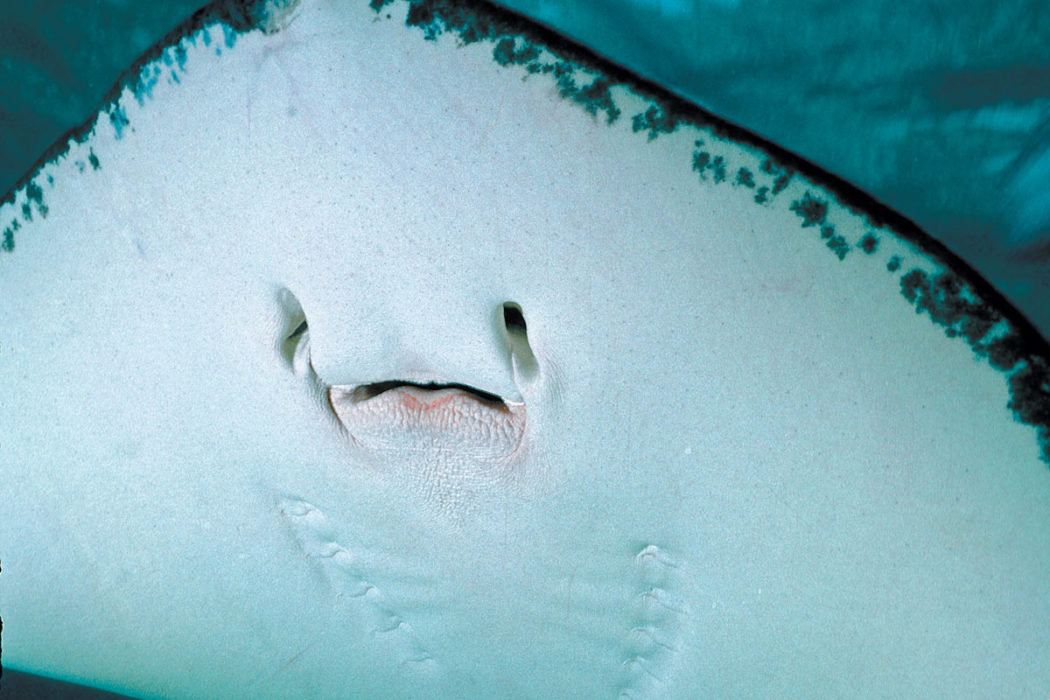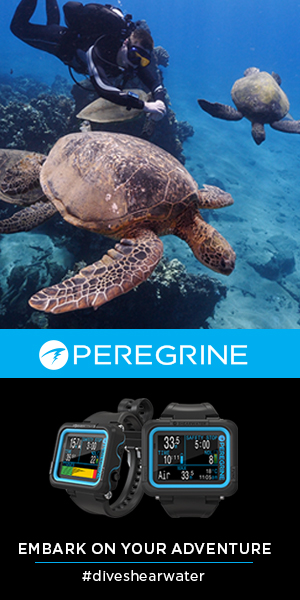Better biology professors teach us not just to record what we see when we look at the world around us, but to think about why things are the way they are. Paying heed to their advice can be extremely helpful in gaining insight into the world of fishes.
Early in your diving career, as you begin to acquire knowledge about fishes, you will learn that factors such as time of year, water temperature and the availability of food play a fundamental role in determining where and how various species live. You will discover that sculpins, blennies, gobies and numerous other species spend the majority of their time on or near the seafloor while other fishes tend to inhabit mid-water or reside at or near the surface. Some fishes, such as tunas and blue sharks, are highly migratory, while others can be found in the same area throughout their lives. Squirrelfishes and cardinalfishes tend to be more active under the cover of darkness while angelfishes and butterflyfishes are far more active during daylight hours.
You will also learn that some fishes such as great white sharks and barracudas are very capable predators while species such as surgeonfishes and tangs are primarily herbivores, and still other species are omnivores, feeding on both plants and animals. While some powerful predators are very fast swimmers, others such as frogfishes, toadfishes and wobbegong sharks tend to rely more on surprise than on raw power and swimming speed.
While fishes use their mouths to feed, they also use their mouths to do things that many animals do with their paws, feet or claws, and that humans do with our hands such as grabbing, carrying, protecting young, nest building and more. As examples, several species of tilefishes and jawfishes use their mouth to help them excavate and maintain their living quarters, and male jawfishes also use their mouths to carry and oxygenate fertilized eggs until they hatch. Taken one step further, some father fishes allow their offspring to swim inside of their open mouths as a haven from predators.
Being aware of this type of information will help you build a foundation of knowledge about fishes. Being a good observer involves taking this knowledge with you when you dive, encountering species in the wild and, based on your knowledge and your observation skills, being able to infer something about the lives of fishes you see.

The two front teeth of the parrotfish are fused, making them especially useful for biting coral. Photo by Marty Snyderman.
All the Better to Eat With
Fishes are equipped with mouths designed for their prey and the way in which they feed. As examples, wolf eels prey upon sea urchins, crabs and a variety of other shelled prey items, while parrotfishes crunch up hard corals to access the algae that live in the corals. The mouths of wolf eels are equipped with numerous strong teeth toward the front and teeth designed for crushing in the back. The two front teeth of parrotfishes are fused, making them especially useful for biting off chunks of coral. Butterflyfishes are equipped with thin, snout-like mouths, a design that is useful for capturing prey that is hiding in small cracks and crevices in reef communities. Employing a “sit and wait” strategy, sea horses use their tube-like mouth to create a vacuum that sucks their prey of small crustaceans into their mouths.
The teeth of various species of fishes also differ significantly in shape and size with strong correlation to their preferred diet. Fish teeth are composed of a bone-like substance known as dentin that is covered with enamel. As is the case with human teeth, fish teeth have a pulp cavity in the center that contains blood vessels and nerves. But unlike human teeth, adult fish do not have a single permanent set of teeth, as their teeth are constantly being replaced.
Some fish lack teeth, while species such as barracudas and walleye have long, canine-like teeth that are used to pin, rip and tear their prey. Still others such as groupers have several rows of closely packed short teeth that look like the tips of a brush and that serve to hold their prey. Groupers tend to gulp down their prey whole using their rasping teeth to prevent their prey from escaping, and their teeth are not used to tear or slash. Flat, broad, molar-like teeth can be found in species like horn sharks that grind and crush their food, and strong, sharply edged cutting teeth can be found toward the front of the mouths of coral-crunching parrotfishes.

The barracuda has long, canine-like teeth used to rip flesh. Photo by Marty Snyderman.
Location and Orientation
Anyone who has ever dabbled in real estate has heard the expression “in real estate, the three most important factors to consider in determining the value of property are location, location, location.” In fishes, if you want to learn about how a fish “makes its living” or captures its food, you will want to note not only the location of the mouth, but also its orientation. In other words, you will want to pay attention to where the mouth is positioned on the head and whether the mouth is pointing downward, straight ahead or upward when it opens.
This positioning and orientation of a fish’s mouth is often indicative of a fish’s feeding habits. In general, there are three ways fish mouths are oriented. Most bony fishes that feed at or near the surface have a slightly upturned mouth, a trait known as an undershot or superior mouth. These fishes often feed on insects or other prey items that reside on or near the surface. The mouths of most bony fishes that inhabit mid-water and that prey upon other fishes are in the front of the face in the terminal position. Fishes that feed along the bottom usually have a mouth that is positioned slightly lower on the face and that opens downward facing the seafloor. Their mouths are said to be in the inferior, or subterminal, position.
The heads of some bottom-feeding species such as goatfishes are also equipped with whisker-like appendages known as barbels. Chemosensory and tactile organs, barbels enable fishes to taste and feel their surroundings to find prey. Barbels can also be observed on the faces of wobbegong sharks, nurse sharks, blind sharks, angelsharks and fishes such as toadfishes and catfishes.
Other bottom-dwelling fishes such as sculpins, scorpionfishes and stonefishes do not dig into the seafloor to uncover prey. Instead they tend to strike at fishes or a variety of invertebrates that swim or crawl nearby. These species are ambush predators that often sit motionless until unsuspecting prey accidentally wander into their strike zone. Then they pounce on their prey.
Like several bottom-dwelling sharks, wobbegong sharks and angelsharks are lie-in-wait predators that use their ability to blend with the substrate to surprise unsuspecting prey that accidentally enter their strike, or hit, zone, an area that is only a foot (30 cm) or so in front of the mouth. When prey, usually small fishes, enter this area a hunting wobbegong or angelshark quickly “leaps” off the seafloor and opens its surprisingly large mouth to catch the prey before it can react. The mouths of these species are in the perfect location at the very front of the head for this capture technique.
In contrast, the mouth of the longnose sawshark, southern stingray, yellow stingray and marble ray — animals that dig through soft sediment on the seafloor to uncover their prey — is on the underside of the head, a better location for a mouth that needs to capture prey from above. On the other hand, manta rays and mobula rays feed on dense concentrations of plankton and their mouths are in the terminal position at the forward end of their head. These rays unfurl their cephalic lobes, the well-developed fleshy structures that project forward of the head, to help them funnel plankton into their mouth when they feed.

The sea horse uses its tube-shaped mouth as a vacuum to suck up small prey. Photo by Marty Snyderman.
Shape, Size and Design
The size and shape of fish mouths are also good indicators of their lifestyles. In general, fishes such as groupers, which prey primarily upon other fishes, have a wide mouth while herbivorous fishes, such as tangs and surgeonfishes, and omnivorous species, such as clownfishes and anemonefishes, tend to have smaller mouths relative to their body size.
A common inhabitant of tropical and subtropical Indo-Pacific reefs, the Moorish idol (Zanclus cornutus) has a rather small mouth at the end of a long, tubular snout. The mouth is lined with a number of seemingly long, bristle-like teeth. The combination of their thin, disc-like body, tube-like snout and mouth position enable Moorish idols to capture a variety of bottom-dwelling invertebrates that reside in the latticework of the reef.
Sharks use an unusual jaw structure that makes their mouths especially effective weapons. In most animals the upper jaw is firmly attached to the skull while the lower jaw moves freely. However, in sharks the upper jaw rests below the skull and can be detached when the shark attacks its prey. The possession of protrusible jaws allows sharks to thrust their entire mouth forward to grab prey. Jaw mobility varies among different species, but all modern sharks share this ability to some degree.
Check Those Pearly Whites
Worldwide there are more than 370 species of sharks. Shark specialists are quick to point out that one of the easier ways for people to appreciate the variety in the shark family is to take a close look at their teeth — a recommendation that is easier said than done. The teeth of sharks are species- or diet-specific, and by comparing the teeth of various species it is easy for anyone to see that the teeth differ considerably from species to species. The teeth of great whites can be more than 2 inches (5 cm) long, and they are triangular and serrated, a design that is extremely useful in helping them rip chunks of flesh out of marine mammals. The teeth of most “reef sharks” are shorter and broader and can be used both for tearing and for crushing. The teeth of mako sharks are long and narrow, and are known to specialists as “fish-eaters teeth.” Makos prey on some of the oceans’ faster swimmers such as tunas, and they use their teeth to impale their elusive prey.
The mouth of the world’s largest fish, the whale shark (Rhincodon typus) has up to 5,000 teeth, but the longest one is only about 3 millimeters (0.12 inches) long. Whale sharks are filter feeders, animals that prey upon copious amounts of tiny creatures known as plankton that reside in the water column. While whale sharks possess cavernous mouths, these sharks do not just depend upon the size of their mouths and their slow forward movement to acquire food. Instead, as suction feeders whale sharks also use their ability to forcefully draw large amounts of food-filled water into their huge maws.

Frogfish. Photo by Marty Snyderman.
The Killer Vacuum
Frogfishes are masters of camouflage, and their ability to blend with their surroundings helps them surprise unsuspecting small fishes they prey upon. Frogfishes deceive their prey into thinking that the prey might gain an easy meal by waving a lure-like appendage known as an osculum that is attached to the hunter’s head above the mouth.
Anyone who has ever seen a frogfish swim would likely agree that in the world of fishes, their swimming skills appear to be lacking. However, they can make extraordinarily quick lunges. In addition, ichthyologists tell us that frogfishes can open their mouths faster than almost any other animal, and they have split-second control over the timing. The speed of the opening actually causes a near-vacuum, thus creating a pressure differential that helps suck their prey into their mouth. Their gill covers are used to help seal the mouth cavity and create the suction.






